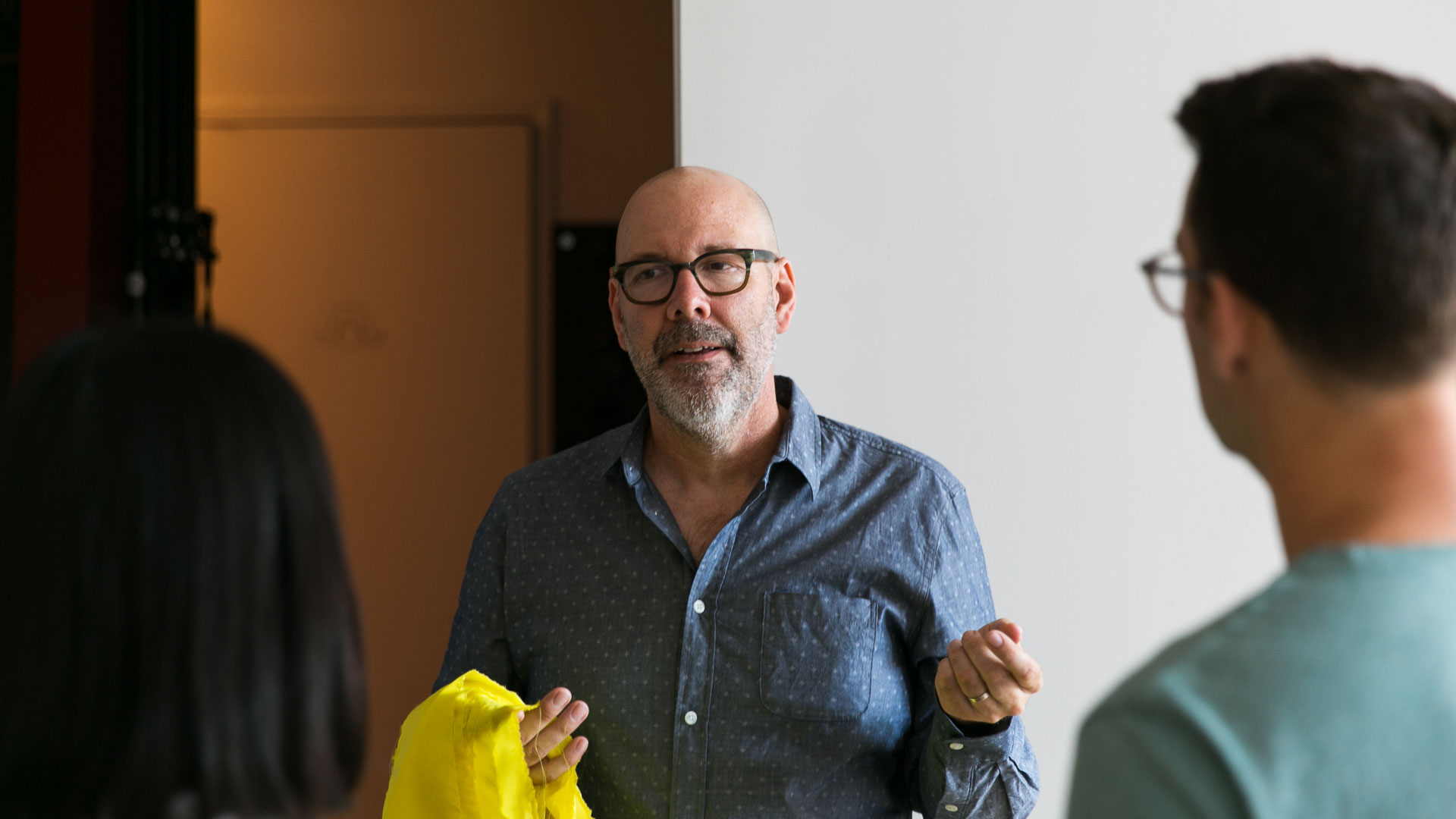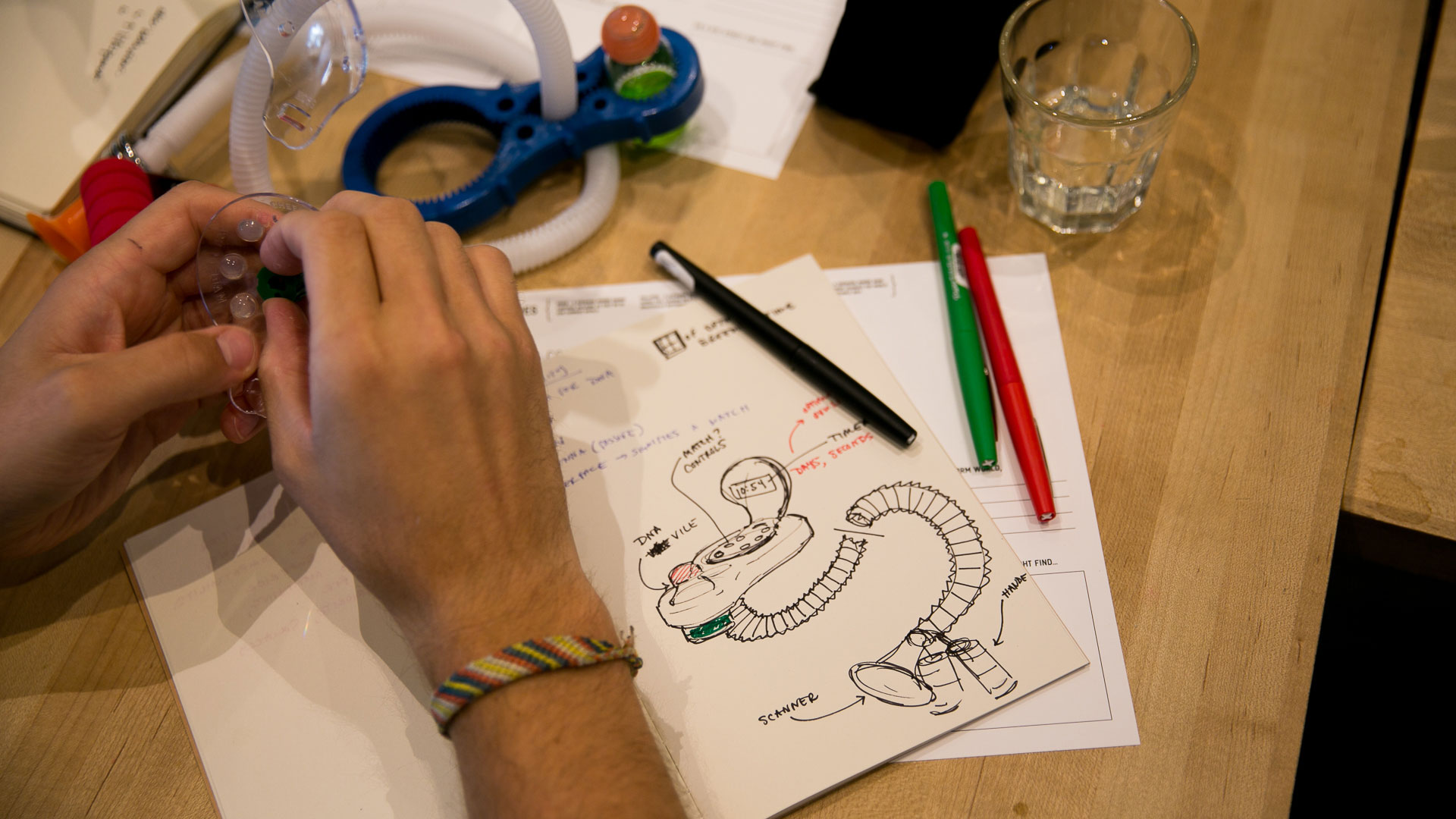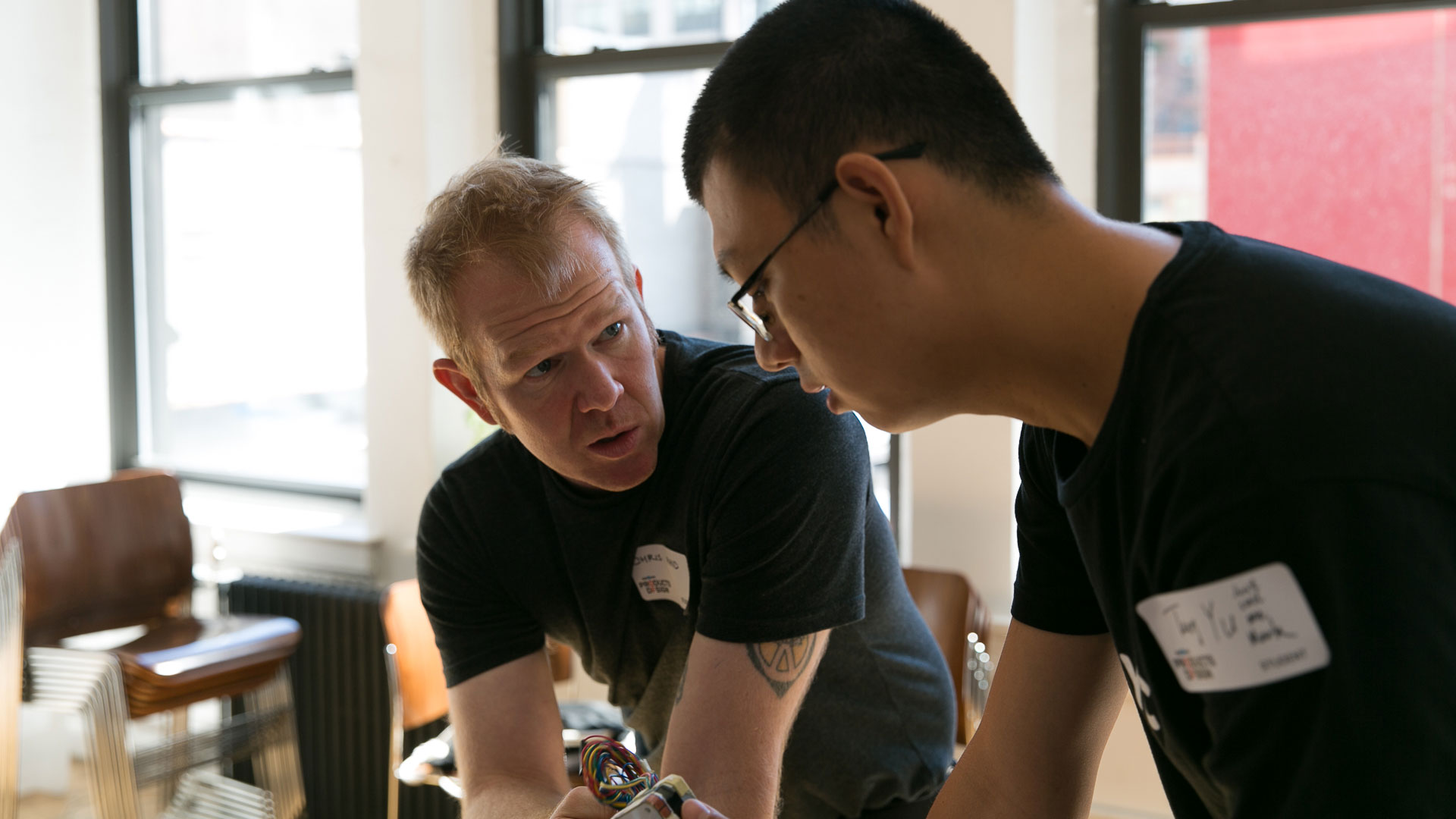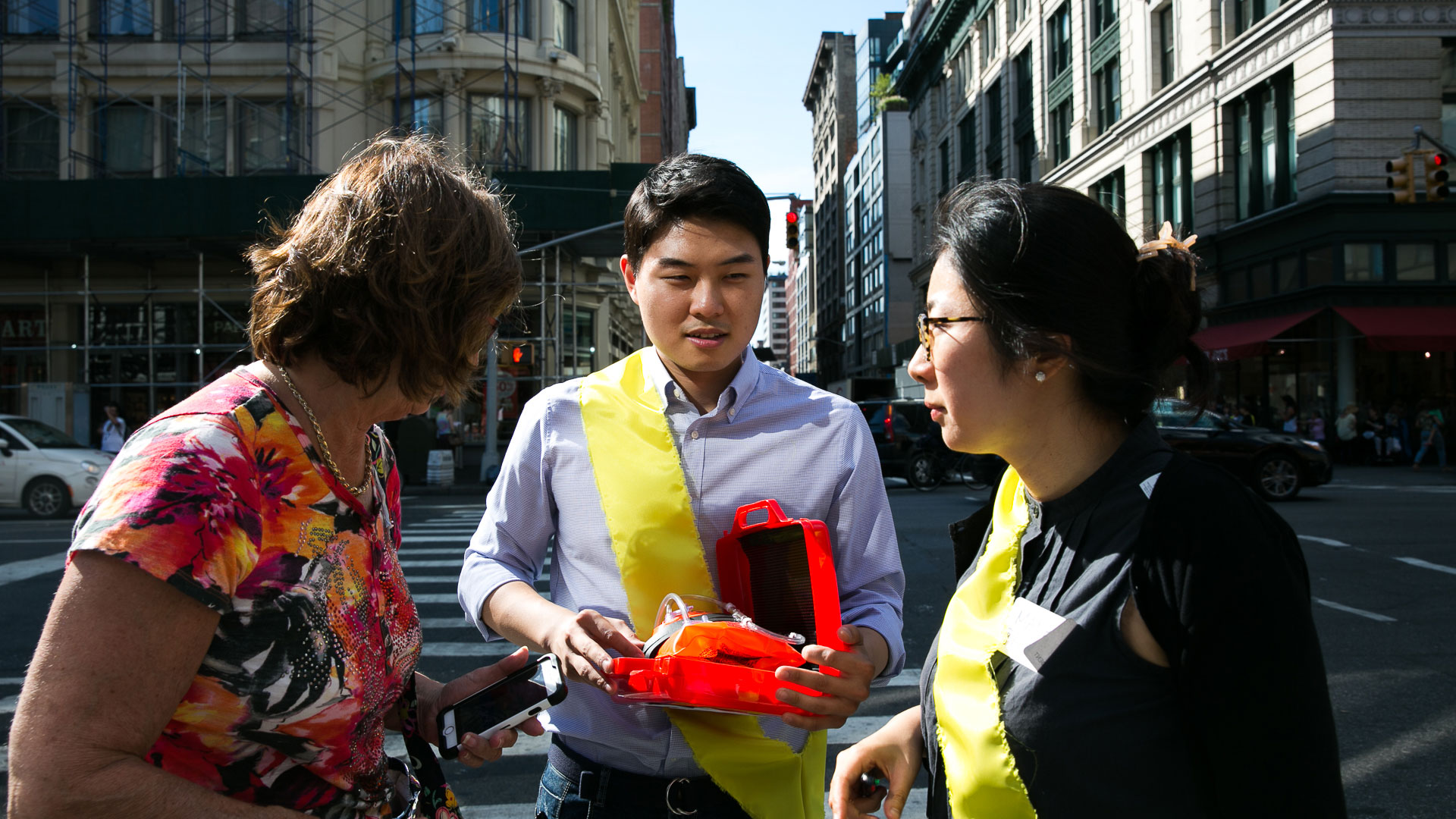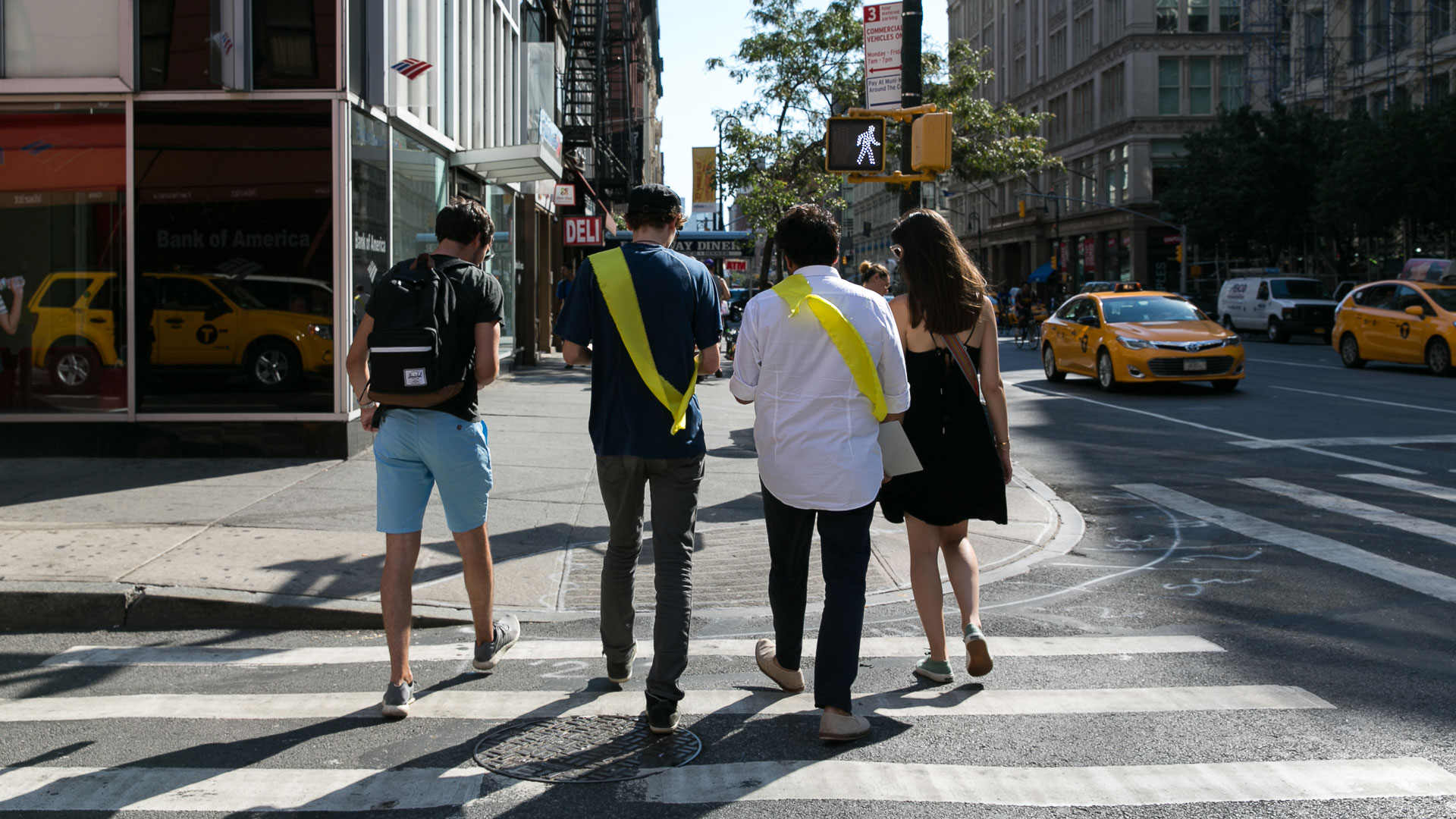Futuring Workshop 2016: Envisioning New Devices and Behaviors For Future Scenarios
For our annual orientation futuring workshop, the Class of 2018 engaged in an all-day speculative design charette led by the Extrapolation Factory's Chris Woebken and PoD graduate Steve Hamilton. Following a lecture presentation on conceptual frameworks around the futuring and speculation, the students dove deep into creating artifacts and behaviors around scenarios triggered by present and near-future scientific phenomena. Let's dive into the results below (and keep in mind that the team projects were conceived, prototyped, and performed "on the streets of New York" all within 4 hours!
(See tons more photos of the workshop in our 2016 Orientation Snapshot blogpost.)
MOMENTS IN MICROBES
Design Team: Antriksh Nangia, Louis Elwood Leach
Scenario
As humanity prepares to colonize Mars, astronauts have been given specially-designed microbes to be used in easing their transition into the unfamiliar environment. These microbes have the ability to produce certain provisions for human survival—such as food and shelter. This ability derives from scientists’ newfound ability to store and feed DNA information into living things.
Product
Moments in Microbes is a device which enables individuals to record the audio, visual, and olfactory data surrounding their everyday lives. This data can be translated and stored within the specialized microbes to be replicated on Mars—with the goal of creating a hospitable, Earth-like world for future human-Martians.
Research
To gain insight on our product, we hosted a Q/A session on the following:
1. Would you be willing to colonize Mars, whereby doing so would allow for Earth to be restored?
2. Would you want to replicate your life on Earth, or start afresh on Mars?
3. Is the data captured by the device sufficient to capture the essence everyday life?
Findings
Our survey indicated a trend wherein respondents rejected the need for such a device—as they would prefer stay on Earth and try to repair what we have from here. On the other hand, some were excited to leave, and would be happy if a product like this were there to ease the drastic transition. Another suggested that a smartphone had the same capacity for information capture, aside from the device’s ability to collect olfactory information.
Mediband Yeast Medicine Kit
Design Team: Manako Tamura, Sebastian Harmsen, Juho Lee
Scenario
Painkillers and other prescription drugs are are often derived via extraction from natural resources such as plants. However, producing these life-saving drugs takes a lot time—and a lot of plants. After years of trial and error, researchers have successfully engineered a form of yeast that can alter the chemical makeup of sugar to create viable medicine for humans.
Product
In the future, the process of creating drugs will be made significantly more accessible. The Mediband is a homemade medicine kit composed of a set of different types of yeasts as well as a wearable arm band. Using the yeast, individuals can produce medicine for various common medical conditions such as diabetes, stomachaches, or headaches. As the medicine becomes ready to use, the arm band expands in size. The medicine will then be painlessly absorbed transdermally through the user's skin.
Research
We presented our prototype, and asked our subjects: 1. Would you use this arm band to take medicine? 2. Have you ever made medicines at home? How comfortable are you with the concept of homemade medicine? 3. How much money are you willing to pay for this kind of product?
Findings
Our research revealed that people felt positively about the idea of taking medicines through an arm band for two reasons: Firstly, many people felt this method was easier than swallowing pills—which they found uncomfortable. Aditionally, the arm band would also help individuals save on resources such as time and money. We found that some people were already familiar with the concept of self-medication, as they commonly used herbal teas and apple cider vinegar for home remedies. As such, people were open and willing to use the device. Finally, our research showed that the expected value of the Mediband would range from 20 to 200 dollars.
THE POP-OP
Design Team: Kevin Cook, Bernice Wong
Scenario
The year is 2025 and three-quarters of the world population have been eliminated due to catastrophic climate change. In attempt to repopulate the earth with genetically resilient humans, we are utilizing technology which allows us to scan and identify living things from small samples of their DNA.
Product
The POP-OP is a tool used by Earth’s remaining inhabitants to scan potential mates and optimize the pairing process based on one’s own DNA compatibility. Superior genetic combinations are judged based on a pair’s ability to generate resilient offspring that will adapt to the harsh climate.
Research
We asked our subjects if, considering the circumstances,
1. This product is ethical;
2. Who should be in control of the POP-OP’s agenda, and;
3. Whether or not this future scenario is likely to occur.
Additionally, we asked our subjects what human traits should be “attractive” to the POP-OP. Lastly, we built a matrix to gauge the public’s reaction to this new device, plotting subjects’ expected rate of adoption against anticipated level of abuse (i.e. scan mates for personal attraction information versus for the benefit of the new population).
Findings
Our research showed that people believed this device would be ethical considering the circumstances, and believed that programming decisions should be in the hands of doctors/specialists/government rather than individuals. People preferred personality traits such a good morals, honesty and strong will over any other human traits. Finally, people expected a high adoption rate, but due to human nature, most believed the device would be abused for personal gain.
ELECTREE CITY
Design Team: Smruti Adya, Will Crum
Scenario
Recent breakthroughs in genetic engineering have enabled us to raise plants with a fraction of the water that was previously required. Additionally, scientists have newly discovered a harmless virus strain that can generate electricity. In a future city with a booming growth of trees, humanity has combined these innovations to meet the high demand for electric power.
Product
The Electree City Project makes use of virus-derived electricity and a tree-rich urban environment, to give power to the people—specifically, as mobile charging stations. Installing an Electree unit takes only a few seconds, and generates a viable change in minutes! Just clip it to host tree, insert the virus delivery nozzle, and plug in your device to the USB outlet for a quick power boost.
Research
In order to gauge consumer interest in the product, we took our prototype to the streets, and asked a few questions:
1. Do you imagine this as a personal device for private use, or as a public utility shared by all?
2. How frequently would you use it?
3. How comfortable are you with using plants as a power source?
Additionally, we asked respondents to indicate their perceived power and water use levels relative to the “average” New Yorker.
Findings
While we originally imagined the Electree unit as a common utility shared by the population, respondents were so impressed by its portability that they all wanted a unit of their own. The majority of people imagined they would use it roughly once a day, while one person expressed environmental concerns about this new technology. (She was curious about the long-term health effects on the host trees.) All respondents perceived themselves differently regarding relative power and water use.
WIND SEER
Design Team: Jiani Lin, Lassor Feasley
Scenario
The year is 2100 and the machines have taken over, destroying nearly all of humanity. Only a small urban colony remains, and it owes its continued survival to a firewall which prevents any digital communication in the region. But the robots have a plan: using methods gleaned from African grasshoppers, the machines have learned to communicate using blasts of highly pressured air. The situation is especially alarming as communication is completely silent and produces no detectable signal.
Product
In order to make the wind-borne communication visible, the Wind Seer features detectors that dangle from an adjustable arm in front of the users’ eyes. A utility light allows the user to read the detectors day or night. Affixed to the left and right sides of the device are compressed air canisters, which when activated, blow air into the wind-borne signal, effectively disrupting communication between the machines. The device conveniently takes the form of a respirator, allowing hands-free use and preventing the user from inadvertently breathing onto the wind detectors.
Research
We ask our subjects if, considering the circumstances,
1. The device made them feel safer;
2. The device made them feel more prepared;
3. The device seem useable.
In addition, we asked if the subjects had greater hope for humanity after seeing the advice.
Findings
Our research determined that many subjects were alienated by the Wind Seer’s unusual form. When asked if the device made them feel more prepared, one subject said, “I am already prepared... for anything!”—indicating that public awareness of the robot menace may be insufficient. Once the threat of digital communications being carried through the wind was properly explained, most subjects said that they did feel more safe after seeing the product. However, the device scored low on usability, even after careful demonstration. Ultimately, the public seemed to come to a grudging acceptance of the device . When prompted on their hope for humanity, one subject said, “I have higher hope now that I know people are working on this type of project.”
GIVING TREE
Design Team: Teng Ju, Christopher Rand
Scenario
Biologists and other scientists have joined forces to develop trees that produce electric light as a by-product of photosynthesis. As a result, streetlights have been eliminated from our urbanscape, creating a new problem: an excess of light, which generates a state of continuous daylight that needs to be controlled or redirected.
Product
Our portable device allows the user to easily connect to trees and house plants to control luminosity, through dimming, on-and-off control, and the ability to redirect excess electricity to power our USB devices. In addition, it has an emergency feature that not only contacts the police, but also provides the user’s exact location for an accurate and timely response.
Research
On a busy New York City corner, we asked people if they would,
1. Support this device;
2. Pay more taxes for the controllable bioluminescent trees, and/or;
3. Use the emergency contact feature.
Findings
All five groups of interviewees were excited by this new technology. Many wanted to see this service and product available, especially if it meant adding more trees to the city. Furthermore, if the electricity generated by the trees would lower their current utility bills, they would rather contribute the difference than pay for the trees separately as a tax. While waiting for their devices to charge, respondents said would use the emergency call feature if they felt in danger or observed any threat to others. In general, people were enthusiastic that this proposed technology would become part of our reality, and were eager to interact with it. Their excitement was best summarized by a child who thought the streets would be “cool like a Christmas tree” all year long.
H2O WALLET
Design Team: Alexia Cohen, Sowmya Iyer
Scenario
In the future, scientists have developed a method to produce gold nano-particles using ocean bacteria. This has dramatically reduced the value of gold, and in turn, made the gold standard obsolete. Clean water, having been made scarce over time, has superseded gold as the most indispensable and valuable commodity. As a result, humanity has turned to using water as its primary currency.
Product
We have developed the H2O Wallet in order to safely and effectively carry out transactions using water. Designed to be worn around the neck, the H2O Wallet dispenses water in precisely measured drops, each of which is equivalent to what we know today as one dollar (500 drops = $500). The mechanism closely resembles a syringe, making it additionally simple to withdraw money from water ATMs.
Research
We posed the following questions to the public:
1. How long is your average shower in minutes;
2. Whether or not this future scenario is likely to occur;
3. How did this future scenario, if probable, made them feel;
4. Does this change your behavior towards water usage?
We built a matrix graphing the public’s reaction to this new device, measuring the product's appeal as a wearable object against its perceived level of security for monetary transactions.
Findings
In designing this object, we sought to provoke people to think about the conservation and use of clean, potable water. Our research showed that while some people truly consider a future with limited drinkable water to be probable, others felt quite indifferent about it. We found that the product’s wearable nature didn’t appeal to many, but received suggestions that it would be preferable if its aesthetic could be customized. Others felt that the H2O Wallet was an interesting and futuristic way of transacting money and would use it as long as it was safe and secure.
EDIBILITY TESTER
Design Team: Andrew Schlesinger, Jingting He
Scenario
In a not-too-distant future, food is in short supply due to overpopulation and a drastic decrease in soil fertility. Additionally, two recent technologies have been developed to add complexity: 1) a new product that makes anything and everything smell like roses, and 2) edible bacteria targeted to keep people skinny and reduce consumption—but unfortunately makes people fatigued.
Product
In order to assist scavengers seeking food, we created a handheld device to identify whether or not potential food is edible—particularly as anything can now be made to smell like roses(!)
Research
We asked our subjects to answer the following questions on a scale:
1. How concerned are you about future food supply? (Little to very concerned),
2. What do you think of the size of the prototype? (Too small to too big),
3. How likely are you to use a product like this? (Very likely to never), and
4. How does this product make you feel? (Optimistic or pessimistic).
We also asked our subjects for general feedback.
Findings
Feedback from our interviews confirmed that this product should exist in a future with a food supply shortage, and may even be useful in today’s market. Interviewees suggested two present-day uses: testing street market food to avoid food poisoning, and evaluating whether products sold as organic were truly as their labels advertises. The biggest resistance we gathered from our interviewees was the potential price of the product.





















